If you are familiar with Naples, you may know that the city was a thriving center of an art form of shell carving known as cameo.
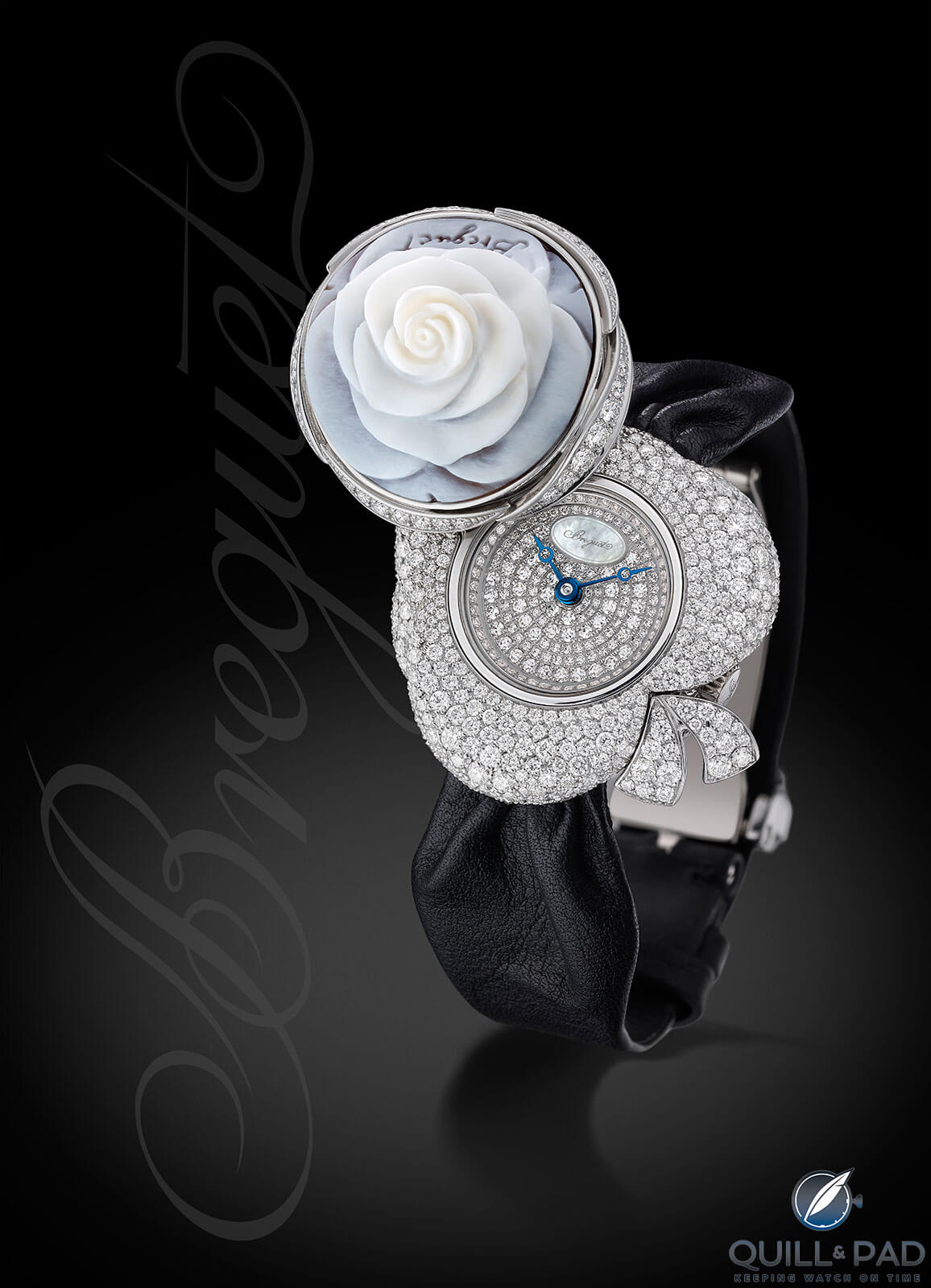
Breguet Secret de la Reine watch open
Cameo is perhaps best known as a jewelry style that has gone in and out of fashion over the centuries. On the other hand, the cameo timepieces Breguet has created using the exquisite carving technique for its Cammea collection should remain heirlooms for the ages.
A brief history of shell cameo
The term cameo is loosely used for a carved object such as a gemstone, glass, or other material. What distinguishes it from other artistic techniques is that it includes a relief image. Historically, the relief image contrasted in color from the background, though today that may not always be the case.
Also, with the mass-production processes available in the modern age, an item may be called a cameo if it looks like one. Something may broadly be called a cameo if it contains an image of a portrait within an oval frame so that it forms a wearable portrait. And this can include any medium, including photography and – popularly – Wedgwood Jasperware.
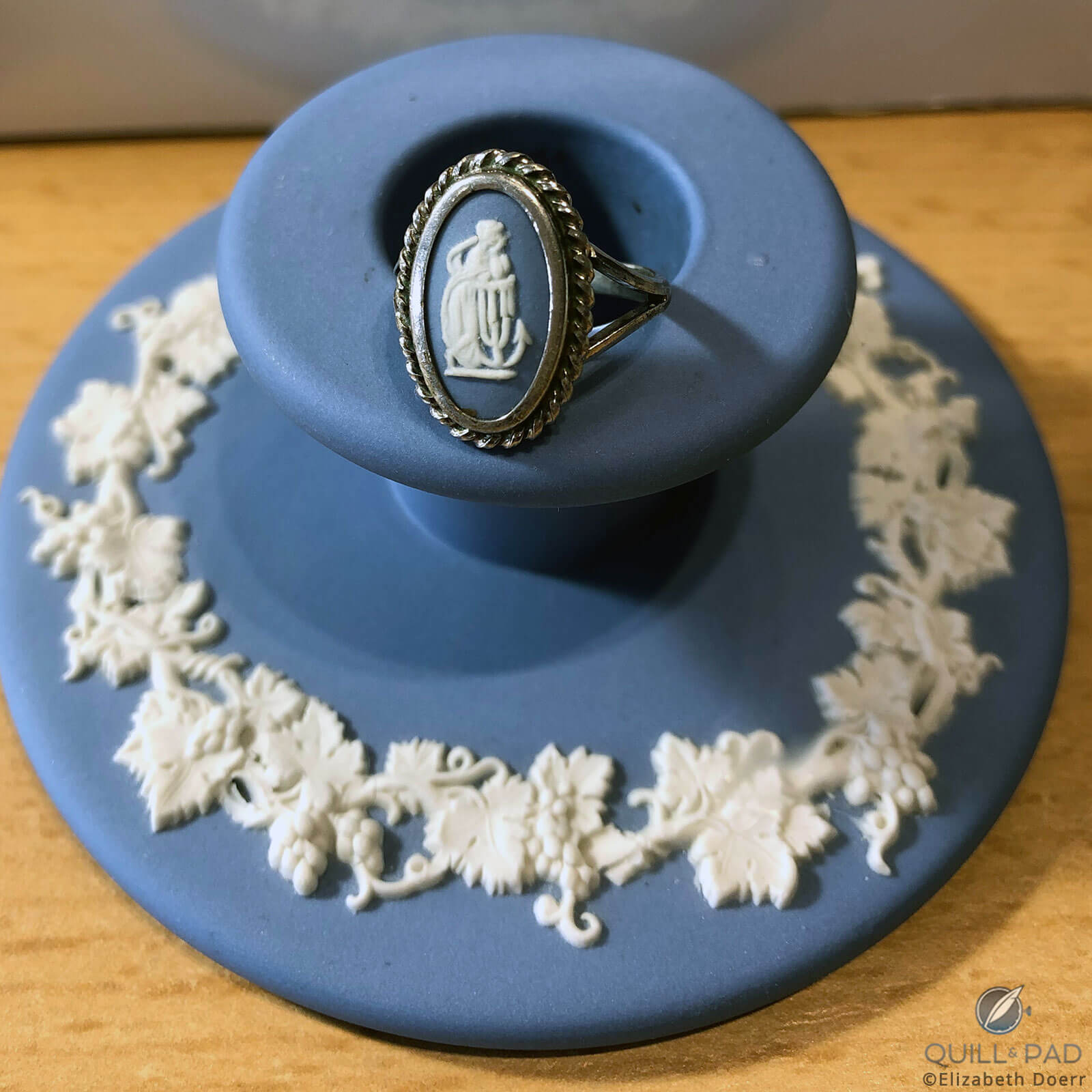
An antique Wedgwood Jasperware ring in cameo style resting on a Jasperware candlestick
But our subject today is proper shell carving, so I’ll stick with just talking about that.
The earliest known shell cameos are from the Renaissance period (fifteenth and sixteenth centuries) with artists utilizing mussel or cowry (mollusk) at that time. New types of shells became available in the eighteenth century due to exploration: helmet shells from the West Indies and queen conch from the Bahamas, for example.
The availability of new, exotic shell types sparked a return of the art with cameos becoming exceedingly popular in Europe and the Americas along with the arrival of the Grand Tour (a traditional trip around Europe), which was customary among upper classes, nobility, and landed gentry from about 1660 to the 1840s, culminating with Thomas Cook’s Cook’s Tour.
Southern Italy as a stronghold of classical antiquity and Renaissance art was almost always included in the itinerary. And cameos became popular souvenirs.
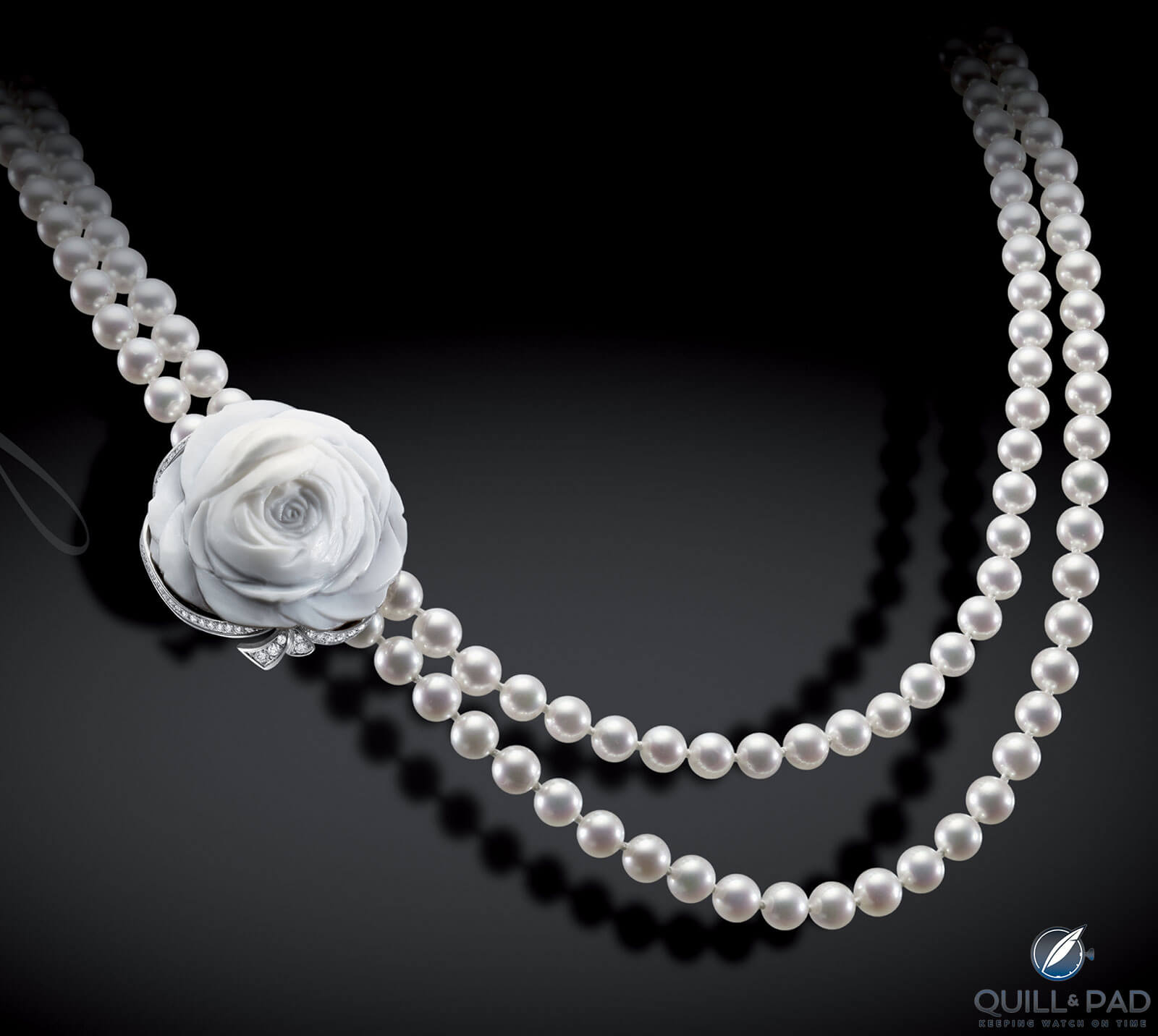
Breguet’s La Rose de la Reine Sautoir with cameo shell and diamond brooch on a strand of Akoya pearls
Neapolitan shell carving
The shell most widely used in good-quality cameo carving since the late nineteenth century has been the bullmouth helmet (Cypraecassis rufa). This shell is typically sourced in Madagascar and South Africa, while the finest examples of the carving are done in Italy – specifically, the world-renowned epicenter of shell carving, Torre del Greco in greater Naples.
Torre del Greco has been a major producer of cameo carving since the seventeenth century. During the rule of Joachim and Caroline Murat, Torre del Greco was the Kingdom of Naples’ third largest city.
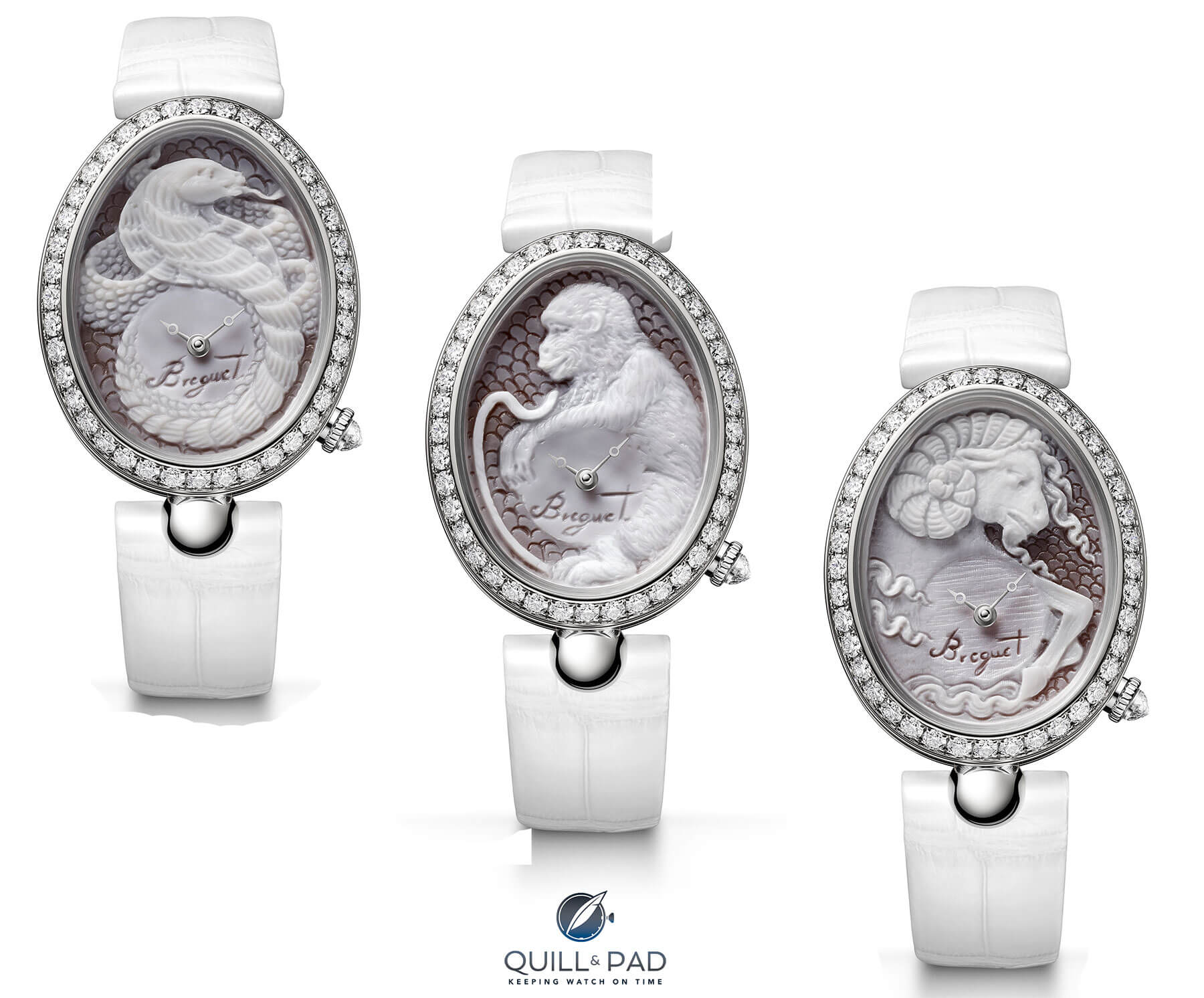
Breguet Reine de Naples Cammea models celebrating Chinese New Year: (L-R) Serpent, Monkey, and Goat
As an aside – and bringing this full circle – Breguet’s “Queen of Naples” watch and jewelry line is named for Caroline Murat, who you can find out more about in The First Wristwatches From Breguet, Hermès and Patek Philippe Were Made . . . For Women. She was one of Breguet’s best clients, purchasing 34 clocks and watches over a span of nine years.
Presently there are several thousand people employed in the shell- and coral-working firms of Torre del Greco, but for our purposes I’d like to concentrate on the artisans involved in making Breguet’s Cammea timepieces.
A century after the cameo’s heyday had passed, young Pasquale Ottaviano began his career as an apprentice engraver in the workshop of Giuseppe Scialanga (Naples, 1889-1960), thus beginning the artistic history of his family in 1947. Scialanga was renowned for miniaturizing the Italian technique of cameo carving.
Upon finishing his apprenticeship of many years, Pasquale Ottaviano began making original creations, thereby gaining international renown. Using first-rate, semiprecious gem and shell materials, he completed his work entirely by hand using only nineteenth-century burins.
It is entirely possible that Pasquale and his son, Fabio, who later entered the family business, are the only artisans of this caliber left in a field that relies more and more heavily on machine-made art.
Fabio not only worked beside his father to learn the skill, he also attended Torre del Greco’s art school (considered the world’s center for cameo carving) and Naples’ Academy of Fine Arts.
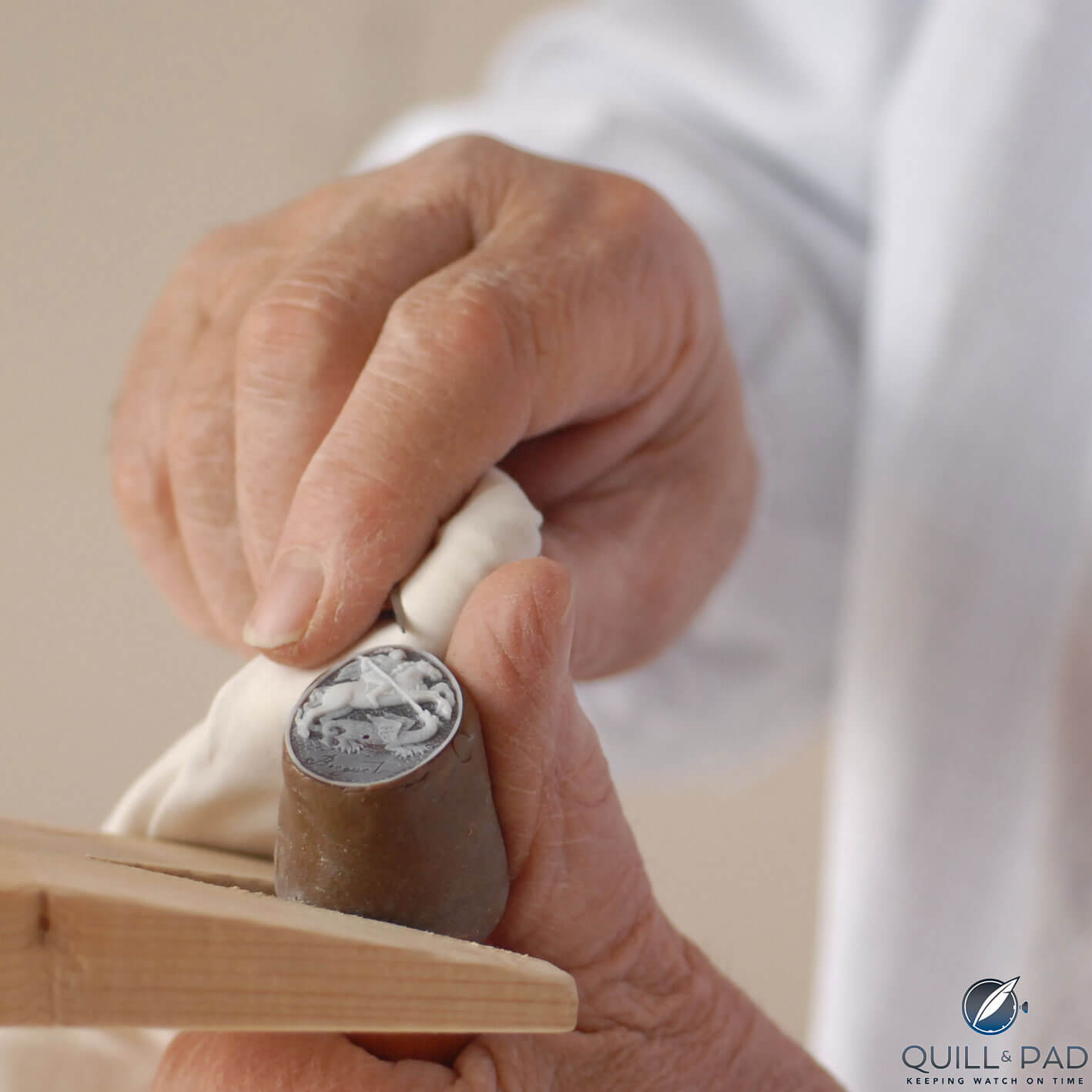
Fabio Ottaviano engraving a dial of Breguet’s Reine de Naples unique-piece Cammea Knight slays Dragon
Fabio’s specific artistic direction lends extraordinary transparency and volume to his figures. When you consider the thickness of the shell that he begins with, what he achieves seems like a tiny miracle. It is the round part of the shell that he uses for his art, first sketching the motif using a pencil.
After that, the shell is cut and refined in shape, specifically including the edges. Then the small “canvas” is attached to a piece of wood for lapping until the white layer of the shell beneath the surface appears, where the artist once again uses the pencil to sketch out his creation. The final step involves engraving with the burin.
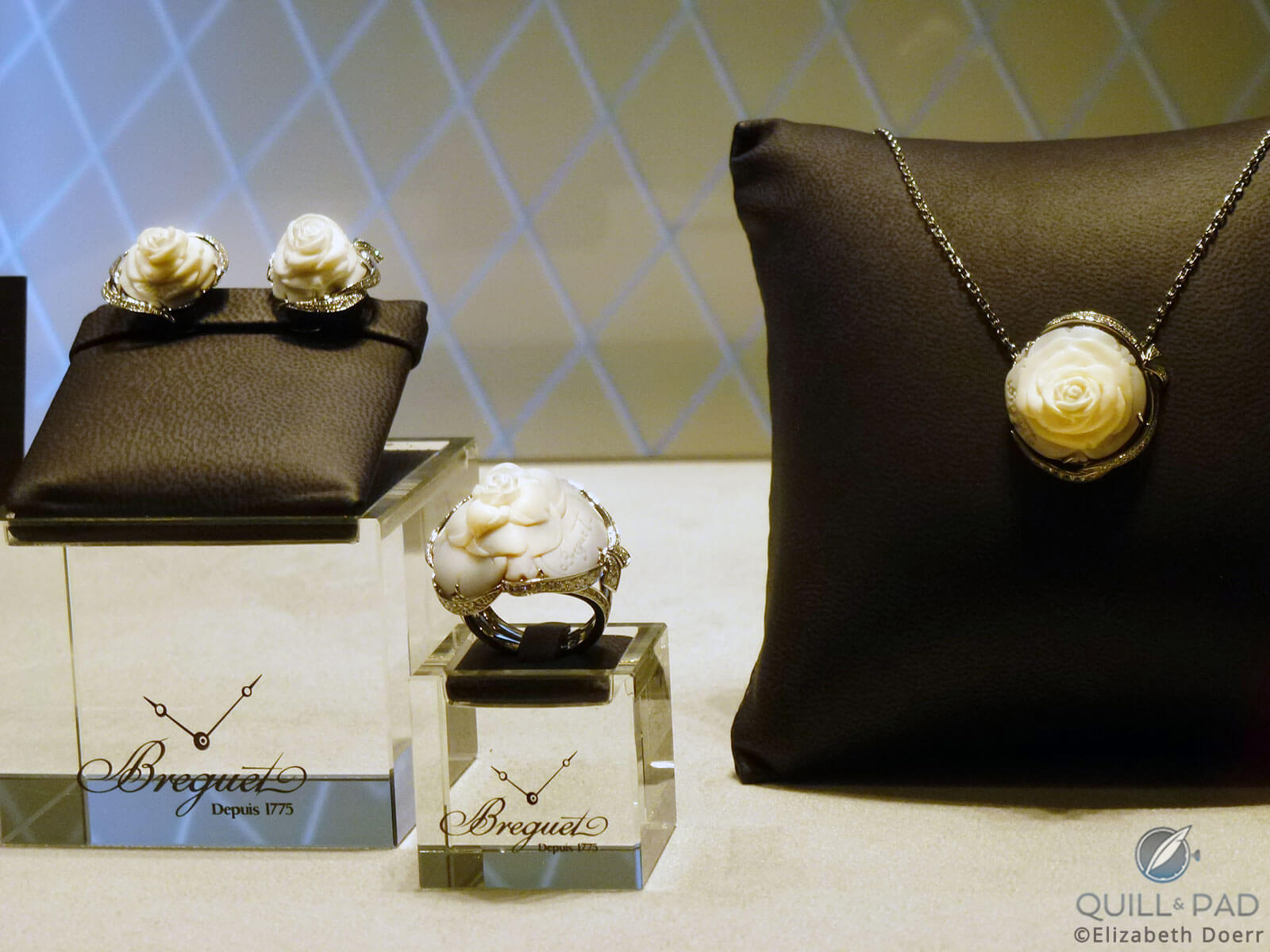
Breguet cameo jewelry displayed at Baselworld
Fabio works with some of the jewelry industry’s leading names, including Breguet, where he has collaborated on a unique wristwatch called Cammea that is fittingly part of the Reine de Naples (Queen of Naples) line.
Breguet is the only haute horlogerie watch brand to have thus far harnessed the beauty of cameo for use in wristwatches.
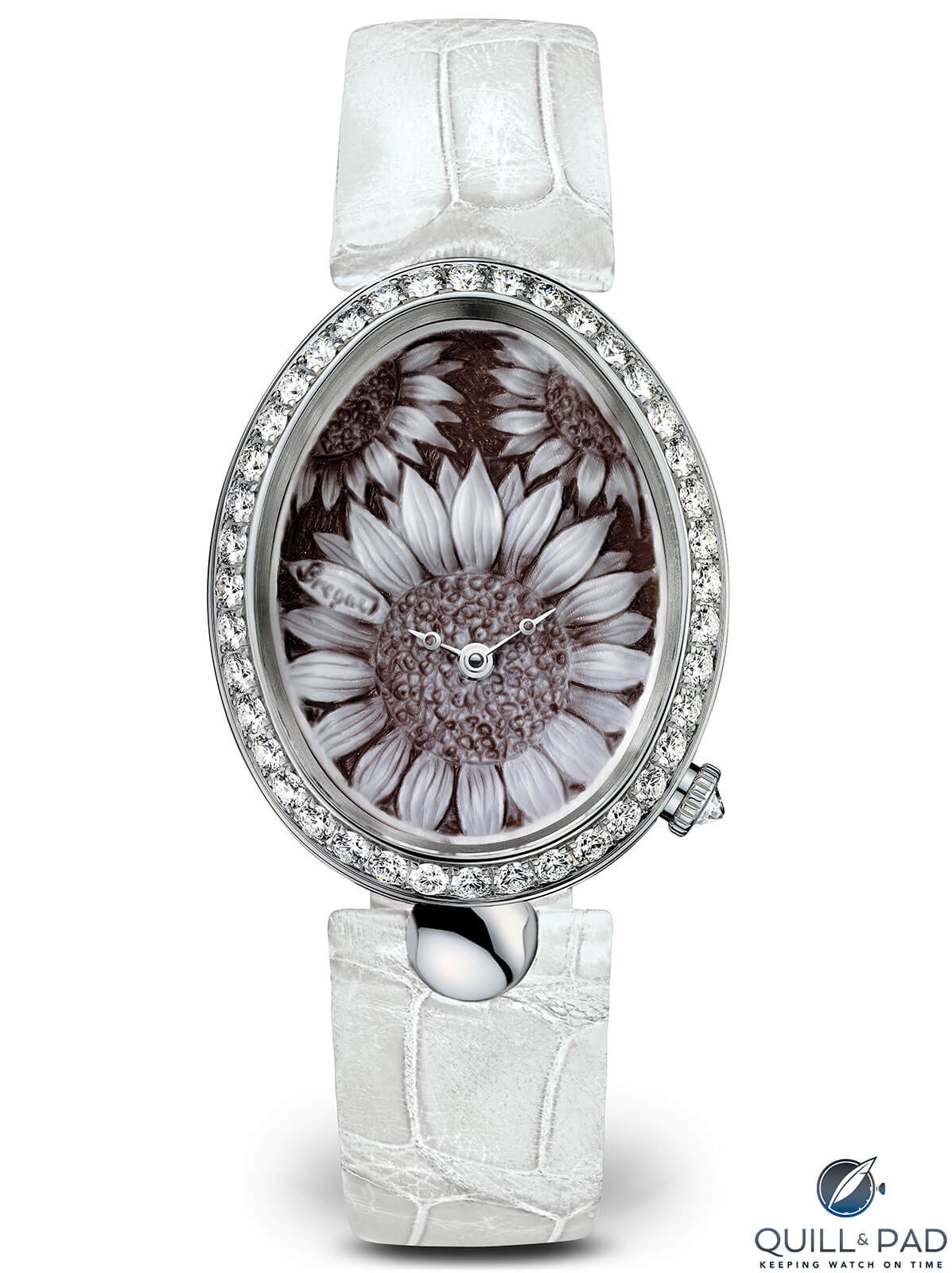
Breguet Reine de Naples Cammea Sunflower
The Breguet Cammea
The Cammea’s sardonyx (Cassis madagascariensis) dial displays an authentic cameo sculpted by hand from the striking shell, which displays a natural color contrast going from milky white to a darker brown further below. The perfect sculpting of this shell allows the foreground subject to appear white against a darker background using the double contrast of color and depth.
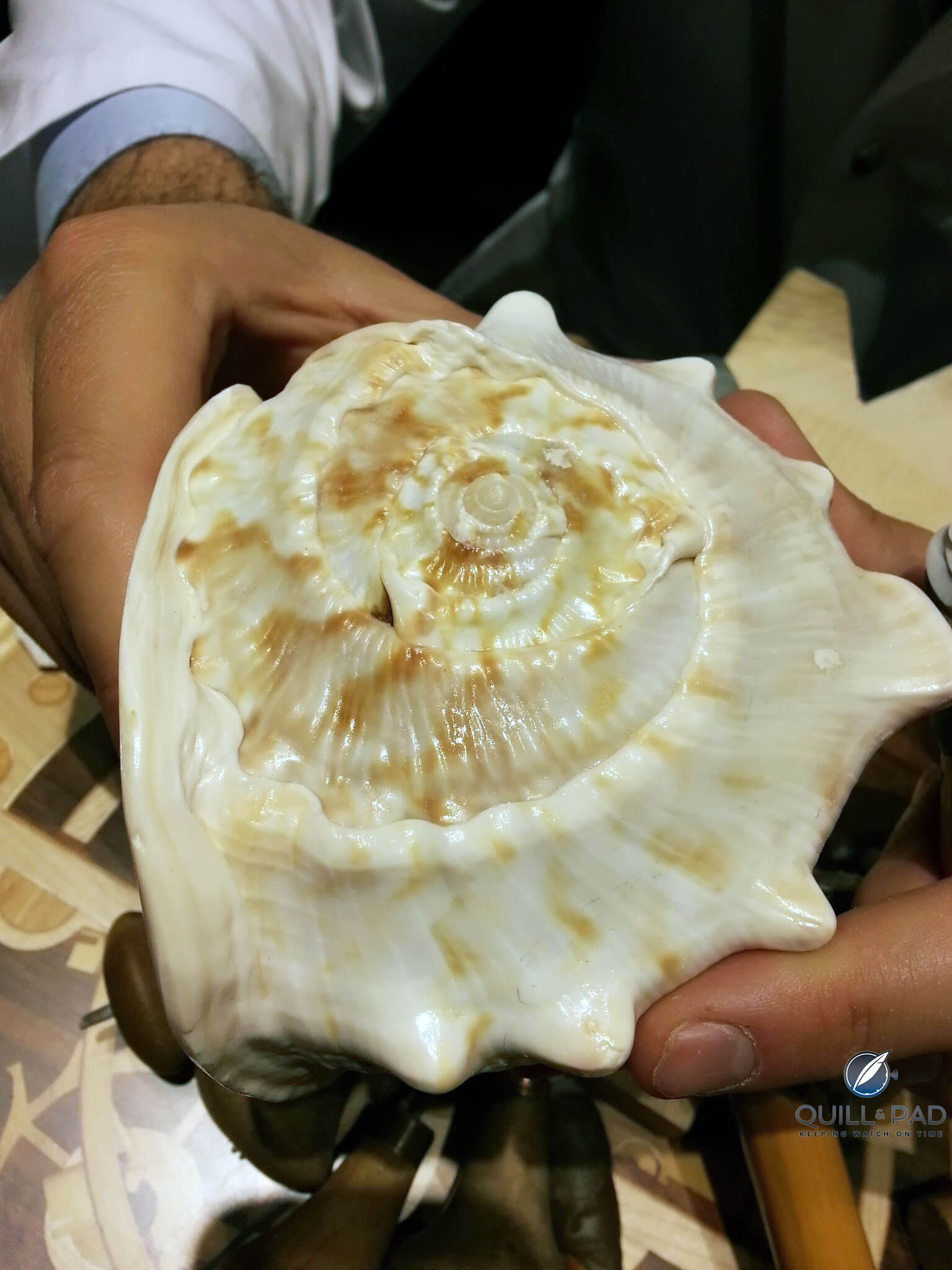
The cassis madagascariensis shell used for Breguet’s Cammea watches
Thanks to the sculptural technique of bas-relief engraving, the dial leaves us with the impression that the subject is raised from the background. In reality it is just the opposite: the relief is cut from the flat shell surface with the extraneous material cut away.
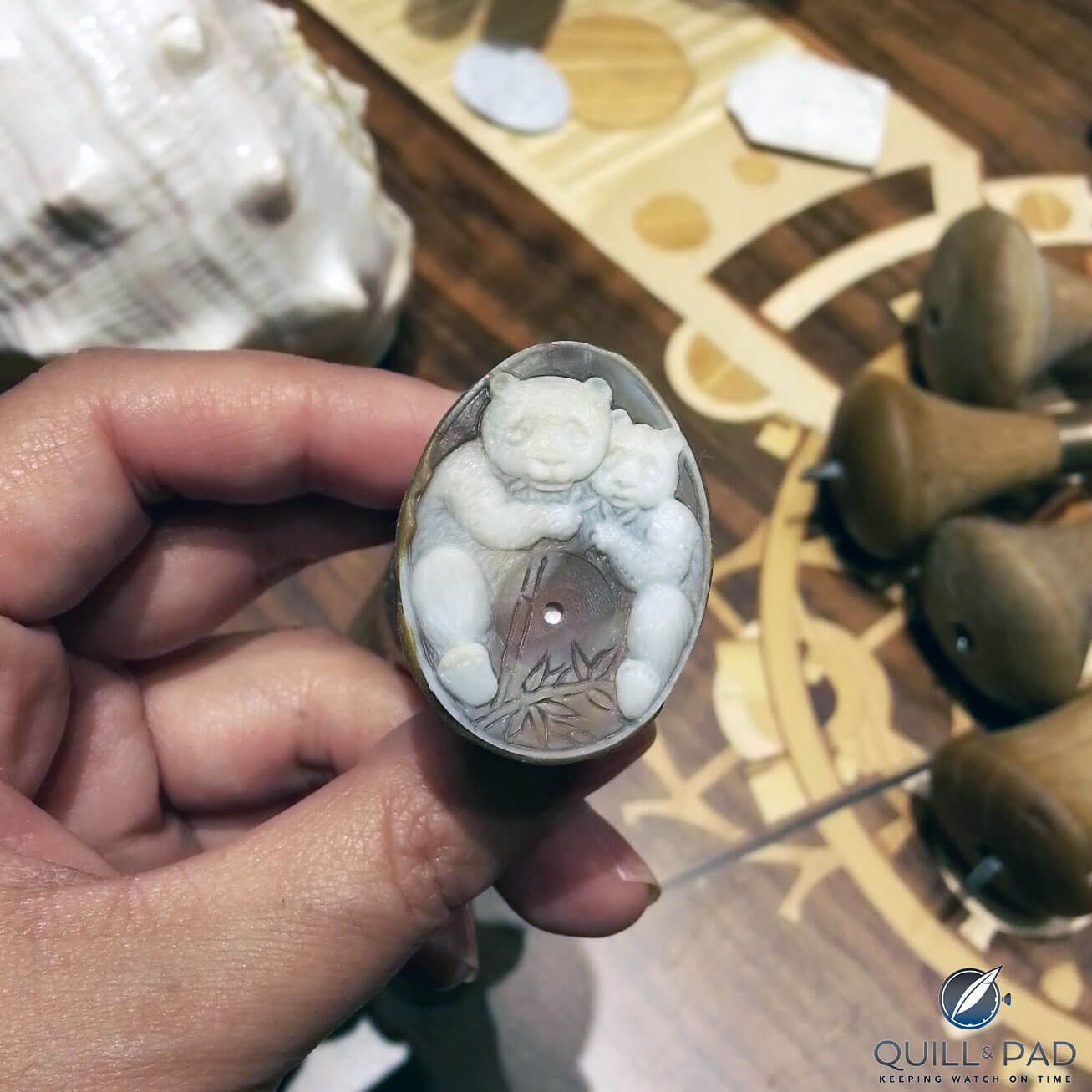
Engraving the dial of one of Breguet’s unique-piece Reine de Naples Cammea timepieces
After choosing the perfect section of shell to make a watch dial, father and son Ottaviano use a simple steel burin to delicately sculpt the chosen figure to approximately two millimeters’ thickness. One shell will only provide enough material for two watch dials.
Classically, the subjects of cameos were derived from Greek and Roman mythology or the portraits of dignitaries (historically, portrait cameos were often gifts to and between royalty), while Breguet has chosen natural – and therefore unusual – themes for its cameo-inspired line: sunflowers and Chinese zodiac animals form the basis.
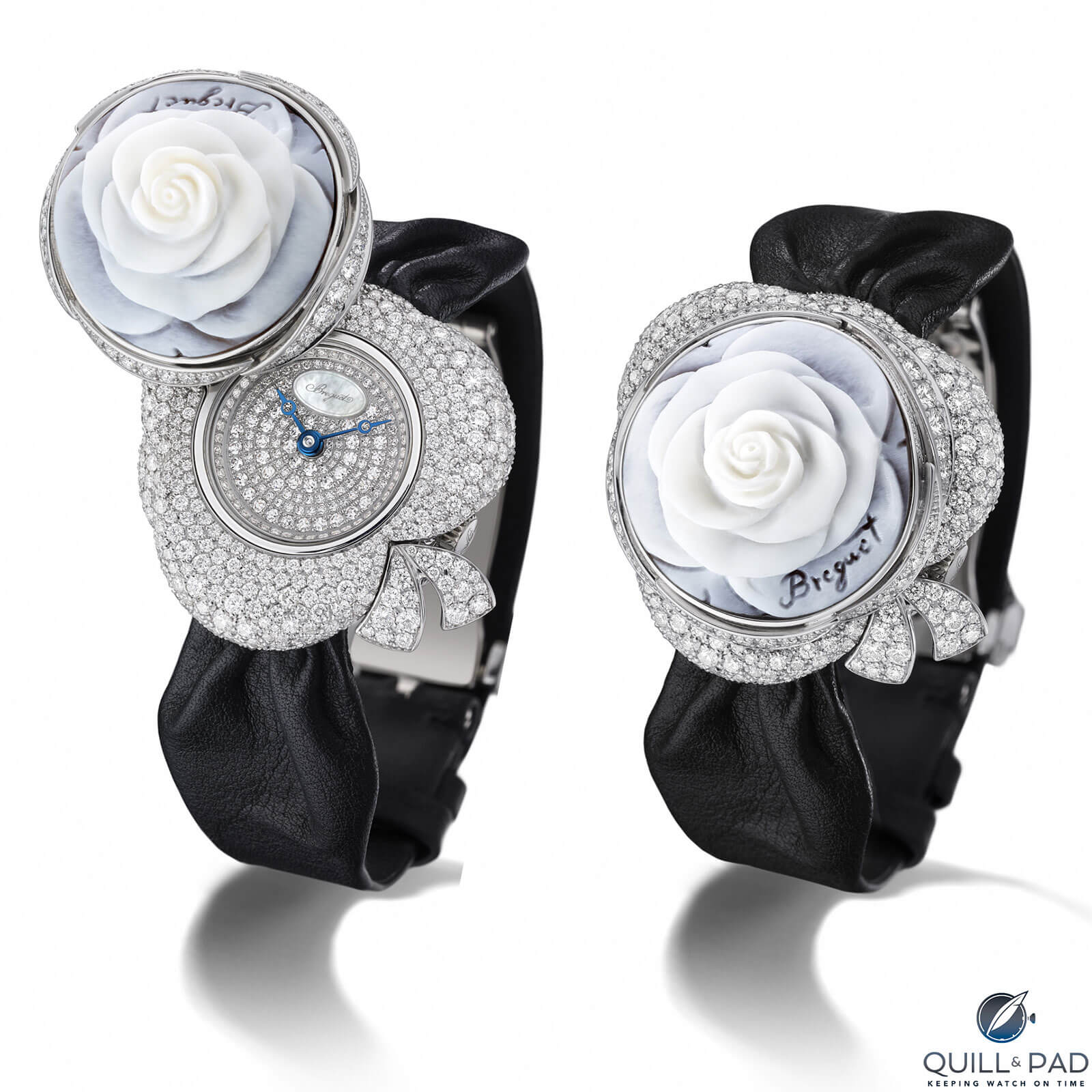
Breguet Secret de la Reine watch open and closed
For more information please visit www.breguet.com/en/timepieces/reine-de-naples/8958.
Quick Facts Breguet Reine de Naples Cammea Reference 8958
Case: 40 x 31.95 x 10.15 mm, white gold set with 40 brilliant-cut diamonds (approx. 2.42 ct); crown set with a briolette-cut diamond (approx. 0.26 ct)
Dial: carved-shell cameo in a variety of designs
Movement: automatic Caliber 537/1 with silicon balance spring, 3 Hz/21,600 vph frequency, 40-hour power reserve
Functions: hours, minutes
Price: $64,800 (sunflower); $72,000 (zodiac animals)
You may also enjoy:
The First Wristwatches From Breguet, Hermès and Patek Philippe Were Made . . . For Women





















































Leave a Reply
Want to join the discussion?Feel free to contribute!